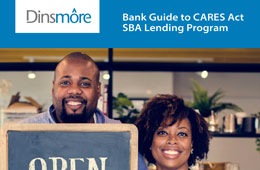Bank Guide to CARES Act SBA Lending Program
March 31, 2020 – InsightA quick legal reference for banks supporting small businesses

Section 1 | Section 2 | Section 3
The Coronavirus Aid, Relief, Economic Security (CARES) Act signed into law by President Donald Trump on March 27, 2020, contains significant relief for small businesses affected by the national emergency declaration related to the COVID-19 pandemic and the aggressive actions taken by state governments across the nation to combat the spread of the virus. Some of the most important items of relief for small businesses in the CARES Act are the nearly $350 billion in Small Business Administration (SBA) loan guaranties, subsidies, and loan programs, targeted at keeping small businesses afloat and assisting them in maintaining their workforces.
Banks will have an important role to play in administering the CARES Act Paycheck Protection Loan Program. This Guide is intended to assist your bank in planning for and implementing its CARES Act strategy.
1. Paycheck Protection Loan Program
Section 1102 of the CARES Act creates a new loan program under Section 7(a) of Small Business Act (the Paycheck Protection Loans). An eligible borrower can receive a Paycheck Protection Loan for up to $10 million to fund certain payroll costs, mortgage payments, rent payments and utility payments. The CARES Act authorizes SBA to make Paycheck Protection Loans through authorized SBA lenders.
SBA Guarantee
Increases the SBA guarantee to 100 percent for Paycheck Protection Loans through Dec. 31, 2020.
Eligible Borrowers
The following entities/individuals are eligible to receive a Paycheck Protection Loan:
- All small business concerns as defined by the SBA;1
- Any business concerns, non-profit (501(c)(3)) organizations, veterans (501(c)(19)) organizations, or tribal business concerns that do not have more than 500 employees, or the applicable size standard for the industry (NAICS) as provided by SBA, if higher;
- Sole-proprietors, independent contractors, and other self-employed individuals;
- Businesses with more than one physical location that employ no more than 500 employees per physical location in industries under an NAICS Code starting with 72 (Accommodation and Food Services)2; and
- CARES Act waives affiliation rules3 for (i) businesses with 500 or fewer employees per physical location in industries under an NAICS Code starting with 72, (ii) business concerns operating as a franchise, and (iii) small businesses that receive financing through the Small Business Investment Company (SBIC) program.
How to Apply
Applicants may apply through an existing SBA 7(a) lender or through any federally insured depository institution, federally insured credit union, and Farm Credit System institution that is participating. Other regulated lenders will be available to make these loans once they are approved and enrolled in the program.
Lenders may begin processing loan applications as early as April 3, 2020.
Covered Period
Defines the covered period for the Paycheck Protection Program as beginning on Feb. 15, 2020, and ending on June 30, 2020. The covered period is used to determine eligibility of the borrower and the time period during which loans made are subject to Paycheck Protection Program provisions.
Loan Amount
The maximum principal amount for a Paycheck Protection Loan is the lesser of: (a) $10 million; or (b) 2.5 times the borrower’s average monthly payroll costs (defined below) for the previous one-year period. For purposes of a Paycheck Protection Loan, payroll costs include:
- Salary, wage, commission, or similar compensation;
- Payment of cash tip or equivalent;
- Payment for vacation, parental, family, medical, or sick leave;
- Allowance for dismissal or separation;
- Payment required for the provisions of group health care benefits, including insurance premiums;
- Payment of any retirement benefit;
- Payment of state or local tax assessed on the compensation of employees; or
- Compensation paid to a sole proprietor or independent contractor up to $100,000 annually (prorated to the covered period).
Payroll costs expressly exclude: (i) compensation to any employee in excess of $100,000 (prorated to the covered period), (ii) compensation paid to a non-U.S. resident, and (iii) sick leave and family leave paid under the Family First Coronavirus Response Act (a separate COVID-19 federal government relief program).
Allowable Uses of Loan Proceeds
A borrower may use the Paycheck Protection Loan proceeds during the covered period for:
- Payroll costs;
- Employee salaries, commissions, or similar compensation;
- Costs to continue health care benefits and insurance premiums;
- Interest payments on mortgages;
- Interest payments on debt obligations entered into prior to the covered period;
- Rent; and
- Utility payments.
We advise loan documentation includes an express purpose of the loan section reciting that proceeds will be used for these purposes.
Determining Borrower Eligibility
SBA delegates eligibility determination to the lenders. Lenders will determine eligibility for Paycheck Protection Loans based on whether a borrower’s business was operational on Feb. 15, 2020, and had employees for whom it paid wages/salaries and payroll taxes (or independent contractors who will receive 1099s). Lenders should establish appropriate processes for verifying the existence of business and employees. The CARES Act does not provide for acceptable verification methods, and SBA has not yet issued guidance. At present, we advise lenders to obtain some or all of the following (this list is not intended to be all-inclusive):
- Certified (by Secretary of State) articles/certificate of incorporation/organization (or the like);
- Good-standing certificate of recent date;
- Written certification of officer of borrower or sole proprietor that the business was operational on Feb. 15, 2020, and had employees;
- Payroll tax payment receipts;
- Internal payroll records of the borrower certified by the officer of the borrower or sole proprietor; and
- Payroll records from a third-party payroll provider.
While not expressly stated, ability to repay Paycheck Protection Loans appears to be irrelevant in the decision to approve the loan.
Borrower Certification
The borrower must certify to the lender that: (i) the loan is necessary due to the uncertainty of current economic conditions caused by COVID-19; (ii) loan proceeds will be used to retain workers and maintain payroll, and make lease, mortgage and utility payments; and (iii) it is not receiving duplicative funds for the same uses from another SBA program. We expect SBA to provide forms for such certification; if you are in need of assistance creating a form in the interim, please contact your Dinsmore attorney.
Collateral and Personal Guarantees
During the covered period, SBA is waiving both the collateral and personal guarantee requirements for Paycheck Protection Loans.
Loan Term; Interest Rate; Prepayment Penalty
- Paycheck Protection Loans will have a maturity of not more than 2 years, and the guarantee for that portion of the loan will remain intact through maturity.
- Maximum interest rate is 1.0 percent fixed.
- Lenders cannot charge prepayment penalties for Paycheck Protection Loans.
Deferment
Lenders are required to defer all payments (principal, interest, and fees) on Paycheck Protection Loans for at least six months, but for not more than one year. Banks should assess and monitor the capital, earnings, interest rate, and other risks attendant to participating in the program. To date, the federal bank regulators have not offered guidance on the Paycheck Protection Loan Program. We expect the federal regulators will issue guidance in the coming weeks. The statute provides that SBA will disseminate guidance to lenders on this deferment process within 30 days.
2. Paycheck Protection Loan Forgiveness
In order to give maximum effect to the stimulus aspect of the program to struggling businesses, Congress deemed it appropriate to provide for forgiveness of Paycheck Protection Loans.
Forgiveness Amount
Borrowers are eligible for loan forgiveness equal to the amount spent by the borrower during an eight-week period after the origination date of the loan on the following:
- Payroll costs (excluding compensation > $100,000 (annualized));
- Interest payments on any mortgage incurred prior to Feb. 15, 2020, (excluding any prepayments);
- Rent payments on any lease in force prior to Feb. 15, 2020; and
- Payment on any utilities (including internet) for which service began before Feb. 15, 2020.
Maximum Forgiveness Amount
Amounts forgiven may not exceed the principal amount of the Paycheck Protection Loan.
Reduction in Forgiveness Amount
Amount to be forgiven will be reduced under certain circumstances.
- Reduced by multiplying (a) the potential forgiveness amount by (b) the quotient of the average number of FTE during the eight-week period divided by (at the option of borrower) either (i) average FTE during 2/15/19 to 6/30/19 or (ii) average FTE during 1/1/20 to 2/29/20.
- If the borrower during the eight-week period reduces by more than 25 percent the total salary or wages of any employee (who makes less than $100,000 per year annualized), then the potential forgiveness amount will be reduced by an equivalent amount.
- However, reductions in FTE or salary/wages that occur between Feb. 15, 2020, and 30 days after passage of the CARES Act, will not be used to reduce the potential forgiveness amount if the borrower reverses the reduction by June 30, 2020.
The loan will be fully forgiven if the funds are used for payroll costs, interest on mortgages, rent, and utilities (due to likely high subscription, at least 75 percent of the forgiven amount must have been used for payroll). Loan payments will also be deferred for six months. No collateral or personal guarantees are required. Neither the government nor lenders will charge small businesses any fees.
Forgiveness is based on the employer maintaining or quickly rehiring employees and maintaining salary levels. Forgiveness will be reduced if full-time headcount declines or salaries and wages decrease.
The loan has a maturity of two years and an interest rate of 0.5 percent.
Borrower Verification
Borrowers are required to verify to lenders their payments during the eight-week period that qualifies for loan forgiveness. The required documentation includes:
- Documentation verifying the number of FTE and pay rates for the periods described above to determine any potential forgiveness reduction (e.g., federal and state payroll tax filing receipts, unemployment insurance filings, etc.);
- Documentation, including canceled checks, payment receipts, transcripts of accounts, or other documents verifying payments on covered mortgage obligations, payments on covered rent obligations, and covered utility payments;
- A certification from a representative of the eligible recipient authorized to make such certifications that the documentation is true and correct and that amount to be forgiven was used to retain employees, make interest payments, make rent payments, and make utility payments, as applicable; and
- Any other documentation the SBA determines is necessary.
Loan Forgiveness Not Taxable Income
Forgiven indebtedness will not be treated as taxable income to borrowers for federal income tax purposes.4
3. Other Implications of Paycheck Protection Loan Program
Regulatory Capital
Paycheck Protection Loans will be treated as zero-risk weight assets for risk-based capital calculation purposes. The statute does not indicate if this treatment will persist until maturity of the loan, or if there will be a sunset of this capital treatment. We expect the federal bank regulators will provide guidance on this topic.
Troubled Debt Restructure
In a previous issuance, the federal bank regulators issued a statement on TDR treatment relief relating to modifications and deferrals for borrowers during this national emergency. The CARES Act provides that modifications to a Paycheck Protection Loan related to COVID-19-related issues should receive the same relief until the federal regulators determine otherwise.
CRA Considerations
In a statement published March 19, 2020, the federal bank regulators jointly indicated they would give favorable CRA consideration to financial institutions that took special steps to serve the needs of their communities during this national emergency. Whether participation in the Paycheck Protection Loan Program will entitle lenders to special CRA consideration is indeterminable at this point. We encourage banks to have early and frequent discussions with their regulators on this point.
1 A “small business concern” must be independently owned and operated, be organized for profit, not be dominant in its field and not exceed certain size requirements for its business classification. The SBA size requirements are broken down by the North American Industrial Classification System (“NAICS”) codes and size standards can be located within the link referenced above.
2 These NAICS Codes covers restaurants, hotels and hospitality industries.
3 Under standard rules SBA may include revenues, employees and other measures of affiliates in determining eligibility
4 This provision does not preclude this amount from being treated as taxable under state and local income tax laws. Borrowers should be instructed to consult their tax advisors in all tax related matters.



